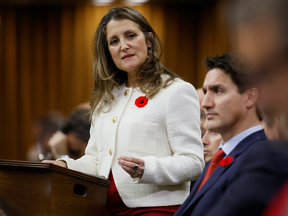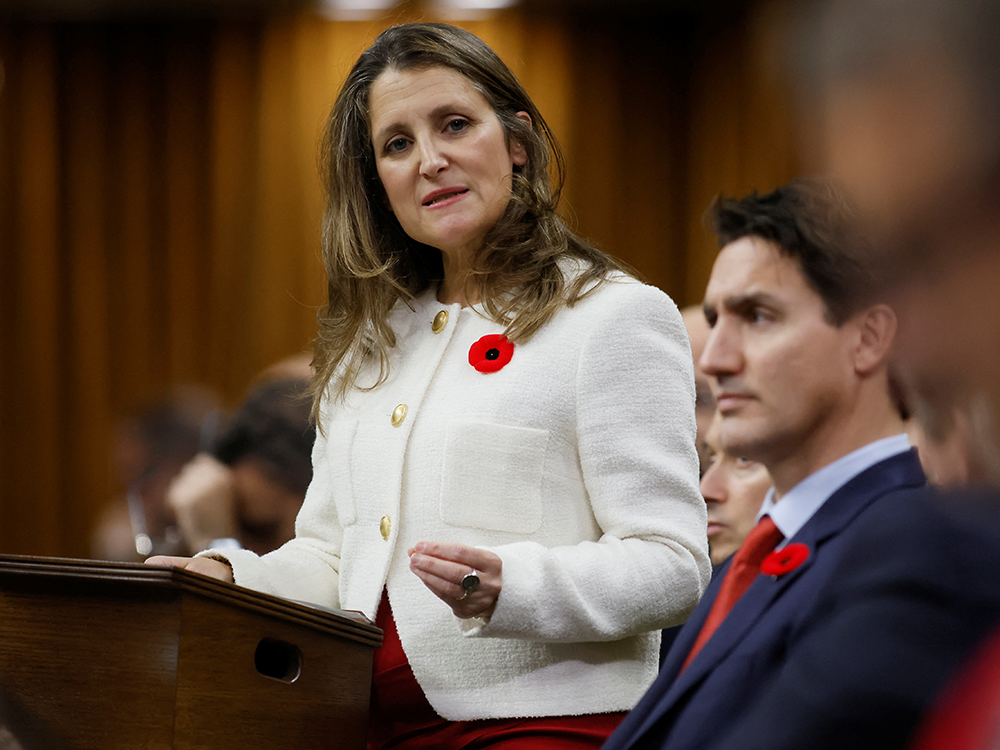But Ottawa should have directed more of a surprise revenue boost to its ‘bottomline’

Article content
The Liberal government’s fiscal update, unveiled Thursday, paints a much different economic picture than the budget released in March, with Finance Minister Chrystia Freeland warning of a possible recession.
Advertisement 2
Article content
Ottawa downgraded its forecast for this year’s gross domestic product (GDP) to 3.2 per cent from 3.9 per cent. It also drastically cut its projection for 2023, and expects the economy to only grow 0.7 per cent from an earlier forecast of 3.1 per cent. Under a downside scenario, Ottawa said GDP could contract by 0.9 per cent next year.
Article content
Article content
However, economists think a 0.7 per cent growth forecast is a bit optimistic, and several expect GDP to come in at 0.2 per cent next year.
There was one upside that came out of the update: “a cool $40-billion” surprise revenue boost that will reduce the 2022-23 deficit to a projected $36.4 billion from the $52.8 billion forecast in this year’s budget, a note from National Bank of Canada Financial Markets said.
Advertisement 3
Article content
Still, economists at the Royal Bank of Canada said they would have preferred to see more of that revenue windfall “flow through to the bottomline,” adding, “program spending in the current fiscal year is the highest in nearly three decades outside of the pandemic.”
Here’s what economists had to say about the fiscal update:
Cynthia Leach and Josh Nye, RBC Economics
“As expected, (Thursday’s) Fall Economic Statement focused on new green growth initiatives with only limited affordability measures that could have complicated the Bank of Canada’s fight against inflation. The government has built some fiscal room with strong nominal GDP growth significantly reducing its key debt-to-GDP in the current fiscal year. But with nearly two-thirds of positive economic and fiscal developments being recycled into new spending, not as much of the revenue surprise flowed through to its bottom line.
Advertisement 4
Article content
Excluding an $8.5-billion provision for ‘anticipated near-term pressures’ (the new risk adjustment?) net new spending over the forecast horizon is nearly equal parts growth- and affordability-oriented, and the latter is fairly well-targeted toward lower-income households. But these measures add to an already-elevated spending track — at 15.7 per cent of GDP, program spending in the current fiscal year is the highest in nearly three decades outside of the pandemic.
Rising public debt charges limit near-term improvement in the deficit profile, which is based on economic projections that now look optimistic (0.7 per cent real GDP growth next year versus RBC’s 0.2 per cent forecast). A downside economic scenario (-0.9 per cent growth next year) shows the government’s finances could quickly go sideways — literally, in terms of debt-to-GDP— and that doesn’t account for additional discretionary spending that would likely come with such a slowdown. While the government has preserved some fiscal firepower heading into what we expect will be a moderate recession in 2023, it might not have quite as much dry powder as hoped if it aims to stick to its fiscal anchor (debt to GDP ratio).”
Advertisement 5
Article content
Warren Lovely, Taylor Schleich and Daren King, National Bank of Canada Financial Markets
“…The FES arrives at a transitional moment for the Canadian economy, with slower growth set to take hold as aggressive monetary tightening works its way through the system. For the time being, however, we continue to receive predominantly positive fiscal news from Canadian governments, owing to a stronger-than-expected glide path for nominal GDP. That trend was well in evidence here, the underlying revenue outlook boosted a cool $40 billion versus budget.
In one form or another, Ottawa has committed a portion of the ‘bonus’ revenue to new measures, the newest of which are (not surprisingly ) focused on ‘making life more affordable.’ The resulting budget deficit for 2022-23, at $36.4 billion, amounts to a relatively contained 1.3 per cent of GDP. The updated deficit tally represents a non-trivial improvement versus April’s budget, where a shortfall of $52.8 billion was forecast, and further extends the federal government’s overall fiscal recovery. Reference note: At the peak of the pandemic, economic disruptions and extraordinary government supports saw the federal deficit swell to $327.7 billion. The deficit was knocked down to $90.2 billion by 2021-22 as the recovery started to take hold.
Advertisement 6
Article content
The medium-term fiscal outlook sees the positive revenue base effect carrying over, notwithstanding an expectation of slower growth ahead. With positive net adjustments more than offsetting new commitments, the FES flags progressively smaller deficits for each fiscal year, culminating with a $4.5-billion surplus in 2027-28 under the baseline scenario. Detailed year-by-year comparisons to April’s budget reveal an average budgetary upgrade of $10 billion a year. Put another way, the cumulative deficit (to 2026-27) is now $60 billion lower than that envisioned in April, which means less federal debt than previously telegraphed (in the here and now and longer term).
Combining smaller deficits with an upgraded level of nominal output could make for nifty progress on the federal debt-to-GDP ratio, which remains the government’s stated ‘fiscal anchor.’ This closely watched metric is slated to end 2022-23 at 42.3 per cent versus the 45.1 per cent level pledged at budget time. The baseline scenario implies only limited progress on debt-to-GDP in 2023-24 before regaining more meaningful downward momentum in the out years of the plan (e.g., debt-to-GDP reaching 37.3 per cent in five years from now).”
Advertisement 7
Article content
-

Ottawa unveils green energy tax credits of up to 40% in bid to keep up with Biden
-

Ottawa aims to balance fiscal restraint with targeted support amid darkening economic outlook
-

Ottawa reveals plan for new tax on stock buybacks
Stephen Brown, Capital Economics
“The $6 billion in new federal spending measures for this year, as outlined in the Fall Economic Update, amount to just 0.2 per cent of GDP and will have little impact on the economic outlook or monetary policy. By utilizing only a small part of the windfall from higher revenues this year, the government has at least succeeded in providing some fiscal support without triggering a self-defeating reaction in financial markets.
“Our GDP forecasts are more downbeat than the consensus, eyeing a 0.2 per cent drop next year and a sharper fall in the deflator, leading us to expect the deficit to widen again to two per cent of GDP next year. The government did at least acknowledge this risk in an alternative set of projections, which are closer to our own. The government’s baseline forecasts conveniently assume that the debt-to-GDP ratio will edge down by 0.1 point to 42.2 per cent of GDP next year, so it will not take much to push it up as we expect. Nevertheless, the public finances will look more favourable than those in many economies and, unless the government has a sudden change of heart when recession hits, fiscal developments should not prevent the fall in bond yields we expect as the Bank of Canada cuts interest rates.”
Advertisement 8
Article content
Andrew Grantham and Katherine Judge, CIBC Capital Markets
“(Thursday’s) fiscal update saw a notable reduction in the deficit projection for the current fiscal year and, even with some less
favourable economic projections from here and modest spending increases, the updated longer-term projections now show a slim surplus being achieved by fiscal 2027/28. The debt-to-GDP ratio is expected to fall to 42.3 per cent in the current fiscal year, from 45.5 per cent last year, and reach 37.3 per cdent by the end of the forecast horizon as it moves back closer to pre-pandemic levels (just above 30 per cent debt-to-GDP).
“The $36.4bn deficit now projected for the current 2022/23 fiscal year (1.3 per cent of GDP) is well below the $52.8bn that was expected in budget 2022, and the $90.2bn shortfall (3.6 per cent GDP) seen in the prior fiscal year. Revenues are expected to be ahead of those prior projections, largely due to higher income tax receipts. The upward revision to revenue projections more than offset somewhat higher spending, including increased public debt charges linked to the rapid rise in interest rates seen so far this year.”



